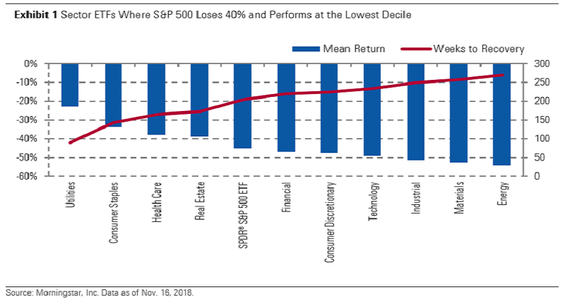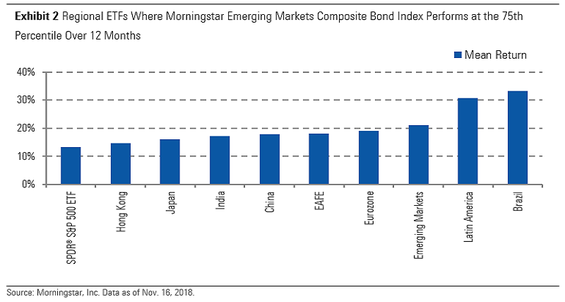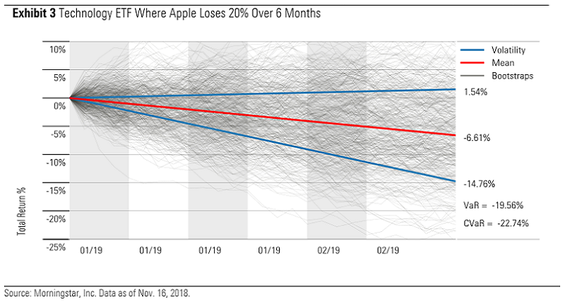What can we expect from the global financial markets over the next six months? We know of a few key trends: the slowdown of global economic growth, the increasing volatility in equity markets, and the Federal Reserve’s balance sheet runoff. United States-China trade disputes and European political turmoil may threaten the stability of many investors’ positions. But at the same time, U.S. short-term bonds have become more attractive, and prospects are bright for Asian emerging-markets equities.
Investors can leverage insights around these imminent events to begin hedging their risks and protecting their portfolio returns, but it’s nearly impossible to predict exactly when the stock market will crash or rally. Rather, the scientific method of scenario analysis is a more effective way to estimate the potential outcomes of hypothetical events, manage expectations, and mitigate risks.
To streamline this process, Morningstar launched the Market-Driven Scenario Analysis tool. This tool enables investors, advisors, and analysts to assess the impact that a market shock to the S&P 500, oil prices, or the price of an individual stock would have on portfolio returns, factor exposures, and volatilities.
The logic behind Market-Driven Scenario Analysis
Market-Driven Scenario Analysis calculates the impact of potential market shocks by evaluating two of the three following parameters: index performance, time horizon, or percentile of the index-returns distribution.
The basis of Market-Driven Scenario Analysis is the “Monte Carlo method,” a statistical process that uses random samplings of risk-factor premiums (that meet the conditions specified in the scenario) to assemble an expectation of portfolio outcomes. There are two main advantages to this method:
- Samples are grounded in empirical market behavior because they are drawn from historical data.
- The tool uses randomness to estimate outcomes even when the deterministic mechanism for the user-defined market shock is unknown. Consequently, investors can investigate the full spectrum of portfolio outcomes without having to specify the particular event that would cause each change.
3 market-shock scenarios, as viewed in Market-Driven Scenario Analysis
In our recently published paper, “ Market-Driven Scenario Analysis for Investment Research: Our 'Oracle of the Midway' Forecasts Return Distributions Using Monte Carlo Simulations,” we demonstrated a number of potential uses of the tool, analyzing how shocks to market indexes or individual stocks would influence a group of sector and regional exchange-traded funds. Learn more about what these analyses look like below.
1. What will happen to a portfolio if the S&P 500 drops 40%?
Market-Driven Scenario Analysis demonstrates what will happen to the sector ETFs under such a circumstance. In this case, we specify S&P 500 performance of negative 40% and constrain the model to the lowest decile. As you can see on the chart below, the utilities and consumer staples sectors do not decline as much as the overall market. Conversely, energy and materials stocks hit rock bottom as a result of this drop, since these sectors are more sensitive to market movements.

2. How will a portfolio respond if emerging-markets debts do well?
The Market-Driven Scenario Analysis tool can evaluate positive as well as negative market shocks to an index. We consider a scenario in which observations are drawn from the upper quartile of the Morningstar Emerging Markets Composite Bond Index’s distribution over a 52-week period. The graph below shows the mean return of the regional ETFs under such constraints.

3. How will a negative shock to a particular stock impact the technology sector?
In addition to shocking a market index, the Market-Driven Scenario Analysis tool can use any individual stock price or time series of returns as an input. In the scenario demonstrated below, we subject the Apple stock to a 20% negative shock over a period of six months and take note of the impact on the Technology Select Sector SPDR ETF. Since Apple is a prominent technology stock, it comes as no surprise that the technology sector ETF will suffer a significant loss.

Scenario analysis isn’t about predicting the future—it’s about managing expectations and minimizing surprises. By mapping out multiple return possibilities, Market-Driven Scenario Analysis provides investors with a clear view of the risks they are assuming, so they can adjust their exposure and plan their strategies accordingly.

